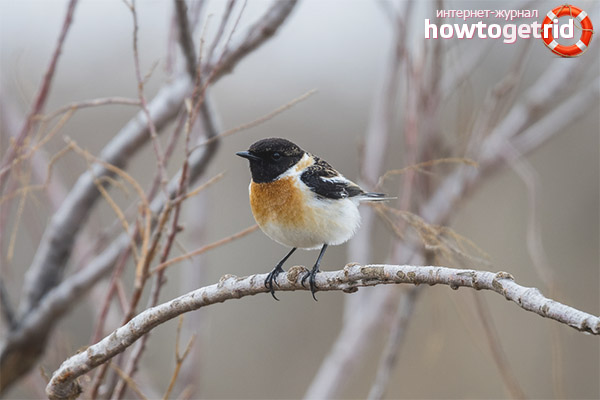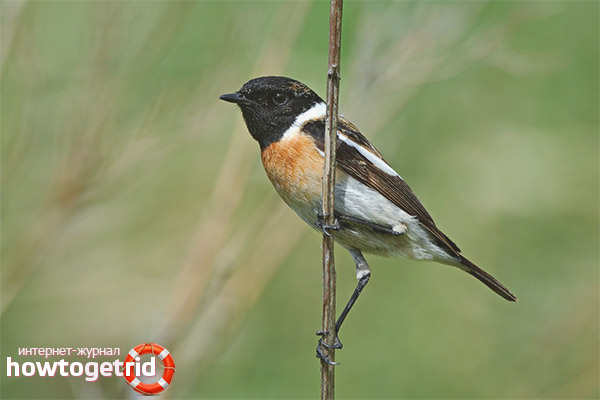The content of the article
By black-headed minting we mean a feathered individual belonging to the blackbird family. According to their overall features, these birds are slightly smaller when compared with house sparrows. Also minted mobile and active, grow up to 15 cm over the body with a body weight of 20 g. respectively. A distinctive feature of the species under discussion is the constantly twitching short tail and the habit of bowing your head in worship. But we will not get ahead of ourselves, studying aspects in order.
Description
- In its characteristics, it is somewhat similar to representatives of the meadow subspecies. Not too large, rounded in format. The length of the body varies between 12-15 cm. With a weight of 12-20 gr. Most of their lives live in bush thickets or tall grass. Earlier it was mentioned that the characteristic is the habit of pulling a shortened tail and bowing your head.
- In the European part of Russia, 3 subspecies of coinage are more common. In the western part, mintings are classified as a subtype of rubikol, varigata is widespread in the Caucasus, and in the eastern side, the maura subspecies are most common.
- Rubicola prefers to live in a dry area, flooded with sufficient light. Males by their external data are determined quite simply. They are characterized by a whitish neck and a reddish chest. The head is black, allowing you to separate this species, for example, from meadow representatives. The females, as well as the young and the males in spring plumage differ from the self-like light area above the tail and eyebrows of the same shade.
- Male representatives of the rubicol subspecies have a whitish collar and a black head. The chest is pigmented in a bright red color, the area above the tail and the lumbar are white with the inclusion of an ocher tone. The tail is completely black.
- Females of the same subtype are more pigmented by red, but their upper part is dark, therefore females are partially similar to meadow representatives. A distinctive feature is the light underbrow eyebrow, as well as the absence of bright spots in the lateral parts. In the lumbar region there are bright areas, as well as above the tail. If you look from afar, it may seem that in this zone there is a whitish inclusion.
- Considering a subspecies of Maura, it is worth saying that males are stained in contrast than individuals of Rubicola. They are light in the abdominal part, above the tail and in the lumbar region. They can be pure white, with a white necklace on the neck and behind it. Maura females are also lighter than the rubikol subtype. They have a bright neck and chin.
- A subspecies of varigata, including individuals of female and male gender, is similar to individuals of Maura. But in the area of the wings there are white feathers. The young of all three subtypes is similar to females, but they have more mottled areas in the upper part of the head, wings and back. And in the lower section are feathers with whitish splashes. In autumn, all species are similar, dull and lighter.
Vote
- The singing of the individuals in question is somewhat reminiscent of torn phrases that can be heard with creaky trills. Such sounds are very similar to the cries of a meadow mint. Only among the feathered birds does the voice sound somewhat monotonous. However, you will not hear an obvious rattle.
- When black-headed coinage is filled with songs, you will hardly hear any sound elements of whistling in them. You can often hear that the individuals in question seem to mock. Often birds sing in trees, poles, tall bushes, and even in flight. At the sight of danger, the birds begin to scream loudly.
Spread
- It is worth noting that in the European regions there are often several subspecies of the considered individuals. The same birds can be found in Africa and Asia. As for the territory of the Russian Federation, only 3 subspecies are common here.
- Black-headed coinage is often distributed from the southernmost points of the country to the northern peaks. In such places, forest vegetation is already beginning to prevail. Also, individuals are very common in the subzone of the southern tundra.
- After wintering, the considered individuals return to their habitat at the height of spring. Birds arrive precisely in the season of greenery. Coins return to the northern regions as soon as the last snow melts.
In many regions, such birds can be found in large numbers or moderate. If you look at the center of European Russia, in this area individuals are extremely rare. In spacious areas, birds are not found at all.
Video: black-headed mint (Saxicola rubicola)











Submit